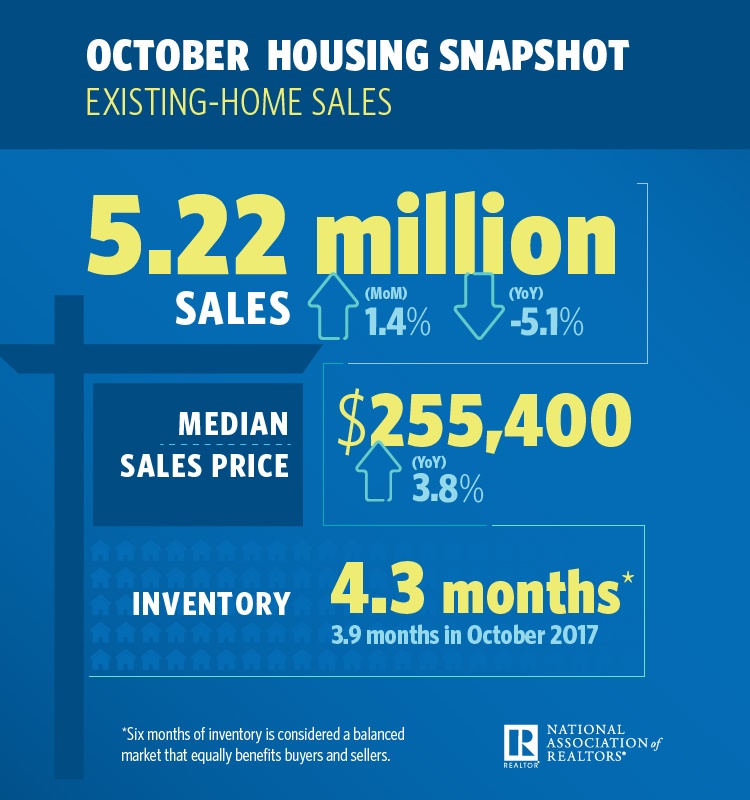October existing-home sales increased last month, after six straight months of decreases, the National Association of REALTORS® reported Wednesday. Three of four major regions saw gains in sales activity last month.
Total existing-home sales, which are completed transactions that include single-family homes, townhomes, condominiums and co-ops, increased 1.4 percent from September to a seasonally adjusted rate of 5.22 million in October. Sales are now down 5.1 percent from a year ago (5.5 million in October 2017).
Lawrence Yun, NAR’s chief economist, says increasing housing inventory has brought more buyers to the market. “After six consecutive months of decline, buyers are finally stepping back into the housing market,” he said. “Gains in the Northeast, South and West—a reversal from last month’s steep decline or plateau in all regions—helped overall sales activity rise for the first time since March 2018.”
The median existing-home price for all housing types in October was $255,400, up 3.8 percent from October 2017 ($246,000). October’s price increase marks the 80th straight month of year-over-year gains.
Total housing inventory at the end of October decreased from 1.88 million in September to 1.85 million existing homes available for sale, but that represents an increase from 1.80 million a year ago. Unsold inventory is at a 4.3-month supply at the current sales pace, down from 4.4 last month and up from 3.9 months a year ago.
Properties typically stayed on the market for 33 days in October, up from 32 days in September but down from 34 days a year ago. Forty-six percent of homes sold in October were on the market for less than a month.
“As more inventory enters the market and we head into the winter season, home price growth has begun to slow more meaningfully,” said Yun. “This allows for much more manageable, less frenzied buying conditions.”
Realtor.com®’s Market Hotness Index, measuring time-on-the-market data and listings views per property, revealed that the hottest metro areas in October were Midland, Texas; Fort Wayne, Ind.; Odessa, Texas; Boston-Cambridge-Newton, Mass.; and Columbus, Ohio.
According to Freddie Mac, the average commitment rate for a 30-year, conventional, fixed-rate mortgage increased to 4.83 percent in October from 4.63 percent in September. The average commitment rate for all of 2017 was 3.99 percent.
“Rising interest rates and increasing home prices continue to suppress the rate of first-time homebuyers. Home sales could further decline before stabilizing. The Federal Reserve should, therefore, re-evaluate its monetary policy of tightening credit, especially in light of softening inflationary pressures, to help ease the financial burden on potential first-time buyers and assure a slump in the market causes no lasting damage to the economy,” says Yun.
First-time buyers were responsible for 31 percent of sales in October, down from last month and a year ago (32 percent). NAR’s 2018 Profile of Home Buyers and Sellers—released in late 2018—revealed that the annual share of first-time buyers was 33 percent.
“Despite this much-welcomed month over month gain, sales are still down from a year ago, a large reason for which is affordability challenges from higher interest rates,” said NAR President John Smaby, a second-generation Realtor® from Edina, Minnesota and broker at Edina Realty. “Prospective buyers looking for their dream home in this market should contact a Realtor® as a first step in the buying process to help them navigate this more challenging environment.”
All-cash sales accounted for 23 percent of transactions in October, up from September and a year ago (21 and 20 percent, respectively). Individual investors, who account for many cash sales, purchased 15 percent of homes in October, up from September and a year ago (both 13 percent).
Distressed sales5 – foreclosures and short sales – represented 3 percent of sales in October (the lowest since NAR began tracking in October 2008), unchanged from last month and down from 4 percent a year ago. Two percent of October sales were foreclosures and 1 percent were short sales.
Single-family and Condo/Co-op Sales
Single-family home sales sit at a seasonally adjusted annual rate of 4.62 million in October, up from 4.58 million in September, and are 5.3 percent below the 4.88 million sales pace from a year ago. The median existing single-family home price was $257,900 in October, up 4.3 percent from October 2017.
Existing condominium and co-op sales were recorded at a seasonally adjusted annual rate of 600,000 units in October, up 5.3 percent from last month but down 3.2 percent from a year ago. The median existing condo price was $236,200 in October, which is down 0.2 percent from a year ago.
Regional Breakdown
October existing-home sales in the Northeast increased 1.5 percent to an annual rate of 690,000, 6.8 percent below a year ago. The median price in the Northeast was $280,900, which is up 3.0 percent from October 2017.
In the Midwest, existing-home sales declined 0.8 percent from last month to an annual rate of 1.27 million in October, down 3.1 percent overall from a year ago. The median price in the Midwest was $197,000, up 2.4 percent from last year.
Existing-home sales in the South rose 1.9 percent to an annual rate of 2.15 million in October, down 2.3 percent from last year. The median price in the South was $221,600, up 3.8 percent from a year ago.
Existing-home sales in the West grew 2.8 percent to an annual rate of 1.11 million in October, 11.2 percent below a year ago. The median price in the West was $382,900, up 1.9 percent from October 2017.
For more information visit www.nar.realtor.
For the latest real estate news and trends, bookmark RISMedia.com.





